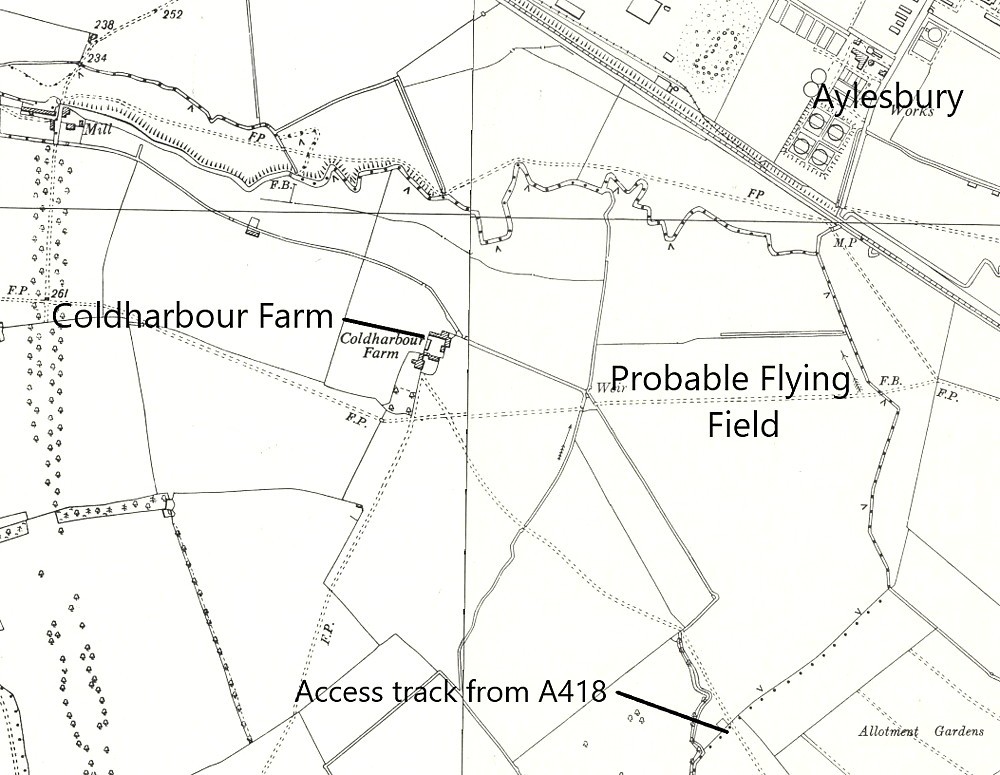Aylesbury flying sites
Note: This map only shows the position of Aylesbury town within the UK.
AYLESBURY (THAME) see also HADDENHAM
AYLESBURY see also HARTWELL HOUSE HOTEL
AYLESBURY see also AYLESBURY WATERMEAD
AYLESBURY: Temporary aerodrome
Operated by: Berkshire Aviation Co
Location: Race Meadow
Period of operation: April 1919 or possibly a tad later
NOTES: Early ‘Flying circus’ venue using a Avro 504K G-EACL.
AYLESBURY - COLDHARBOUR FARM
Location: About 1nm W of Aylesbury town centre
Period of operation: 16th September 1929
This was the 81st venue for Sir Alan Cobham’s 1929 Municipal Aerodrome Campaign Tour. Perhaps for that matter the venue for Cobham’s 22nd April 1932 visit to Aylesbury by his National Aviation Day Tour of the UK?
AYLESBURY was originally planned to be the 77th venue for the 1929 'Tour'. Starting in May and ending in October one hundred and seven venues were intended to be visited. Mostly in England but with two in South Wales and six in Scotland. The AYLEBURY venue was visited in mid September on the 16th. Due to a couple of crashes and other setbacks, Cobham eventually managed to visit 96 venues - which was of course still a magnificent achievement.
He certainly moved around during this 1929 'Tour'. The previous venue was Chatham (KENT) and the next was Colchester (ESSEX). The aircraft Cobham mostly used was the ten-seater de Havilland DH61 'Giant Moth' G-AAEV named 'Youth of Britain'. The punishing schedule he set himself for this Tour seems astonishing today. Also highly recommended are his memoirs in 'A Time To Fly'.
A MICHAEL T HOLDER GALLERY
Note: The second item, the advert, was published in the Bucks Herald on the 13th September 1929. Interesting to note, for those taking a keen interest in detail, that the aircraft is described by its engine, not its manufacturer, and has now become a twelve-seater!
The newspaper article above, divided into two parts to make it easier to read, was published in the Bucks Herald on the 20th September 1929. The last item, the area view, was added from my Google Earth © derived database.
A NEW ERA
It is of course impossible to determine exactly how much influence this Tour by Sir Alan Cobham actually had. But, it would appear, it may well have been very effectual in certain quarters. What is without any doubt is that new regional aerodromes and airports started appearing in the early 1930s, and with them, the emergence of many regional airlines. Usually lacking in financial backing, and embued with optimism rather than a good idea of how passenger traffic could be generated, many quickly failed.
However, some routes proved to be very lucrative, and indeed, prospered until a certain deluded Austrian, Adolph Hitler, gained control of Germany and decided to declare war across Europe. Following on from this, the concept of regional airlines never really recovered in most of the U.K. Feeder services between major airports have of course survived, and many local services, mainly in Scotland, do very well.
However, Cobham's grand concept of linking most larger towns by air, has failed. For a number of reasons. Despite the Beeching cuts to rail services in the 1960s, the rail networks were slowly getting much better. Plus, the emergence of people being able to afford cars, and the road network being improved with motorways and bypasses, meant that the concept of flying over mostly short distances, at considerable expense, became a nonsense.
We'd love to hear from you, so please scroll down to leave a comment!
Leave a comment ...
Copyright (c) UK Airfield Guide























